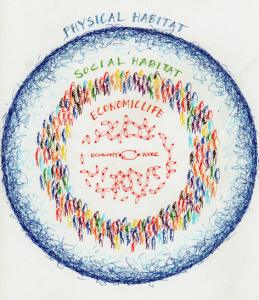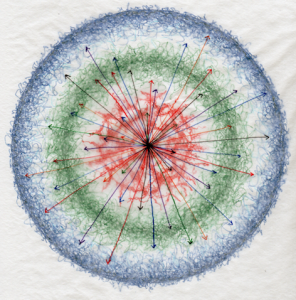Ecosphere intelligence is both our ability to locate human settlements in appropriate locations and our ability to shift and to forever adjust with changing conditions to our habitat. As a species, we clearly exhibit this intelligence as we continue our migration across the planet and into cities. (Please see early Nest City posts: Are people growing cities or are cities growing people? and Driven to do more than merely survive.)
At every turn, we have chosen places to settle depending on geography, for example. These choices have life and death results. The choice to settle in St. John’s, Newfoundland had everything to do with ecosphere intelligence: an ice-free, protected harbour at the eastern most point of NorthAmerica with abundant fish stocks. Much as Jane Jacobs wrote, Hamilton notes that our cities have begun in relationship with their specific physical habitat. We choose places to settle because they make sense. This relationship with our habitat continues, even if we have stopped noticing. At every turn our cities are adjusting:“…the stability of our cities is forever dynamic.”[1].

Our ecosphere intelligence applies both to establishment of a settlement and to a city’s ongoing existence. The fundamental relationship is between everything we do – our work – and our habitat (Figure A – City Dynamic). Cities are the result of our evolving interaction with our habitat.
To continue, our cities need quality feedback from our habitat to ensure that we are able to adjust. The quality of the relationship between our economic life – our work- with our social and physical habitats dictates our ability to generate cities that meet our economic, social and physical needs. The feedback loops within this dynamic are what give us our ecosphere intelligence. Without the feedback, we do not have this intelligence.

Here is a big question – How do we organize for ongoing, quality feedback for our cities? the good news is that we already know how to do this. We have been doing this for thousands of years. Every time, as a species, we set up a new settlement and every time that settlement has shifted to accommodate changing conditions, we exhibit this intelligence. We adjust to the changing weather conditions over the short and the long term. We adjust to the physical changes we ourselves make to our habitat and we keep growing. We know how to do this.
____ ____ ____
This post is the third instalment in a series of posts about Marilyn Hamilton’s 12 evolutionary intelligences for the Integral City. The first two posts outlined four ways of looking at cities as whole human systems: integral intelligence part 1 and part 2. The four integral maps in these posts are critical to understand the future development of our ecosphere intelligence. Our cities are becoming more complex, which is in itself a life condition to which we have to respond. Our usual ways of obtaining feedback about our cities are of an era of earlier complexity. Think about the census as opposed to the practice of analytics now, where data is everywhere. more and more open to the public. Public decision-making is becoming more public.
I don’t know what ecosphere intelligence will look like in a few short years, but I know we will use it. It’s what we do. As we organize ourselves in cities, we will use this data to create feedback loops to form and inform our decision-making in cities. It is time to create the conditions for us to dynamically steer our cities to the future. This is what it will take to create cities that serve us well: being in tune with our habitat and forever evolving with our habitat.
Tomorrow’s post is about Emerging Intelligence – seeing wholeness and aliveness in the city
____ ____ ____
If you are interested in learning more about evolutionary intelligences relating to cities, you need to know about the Integral City eLaboratory – Co-Creating the Future of the Human Hive